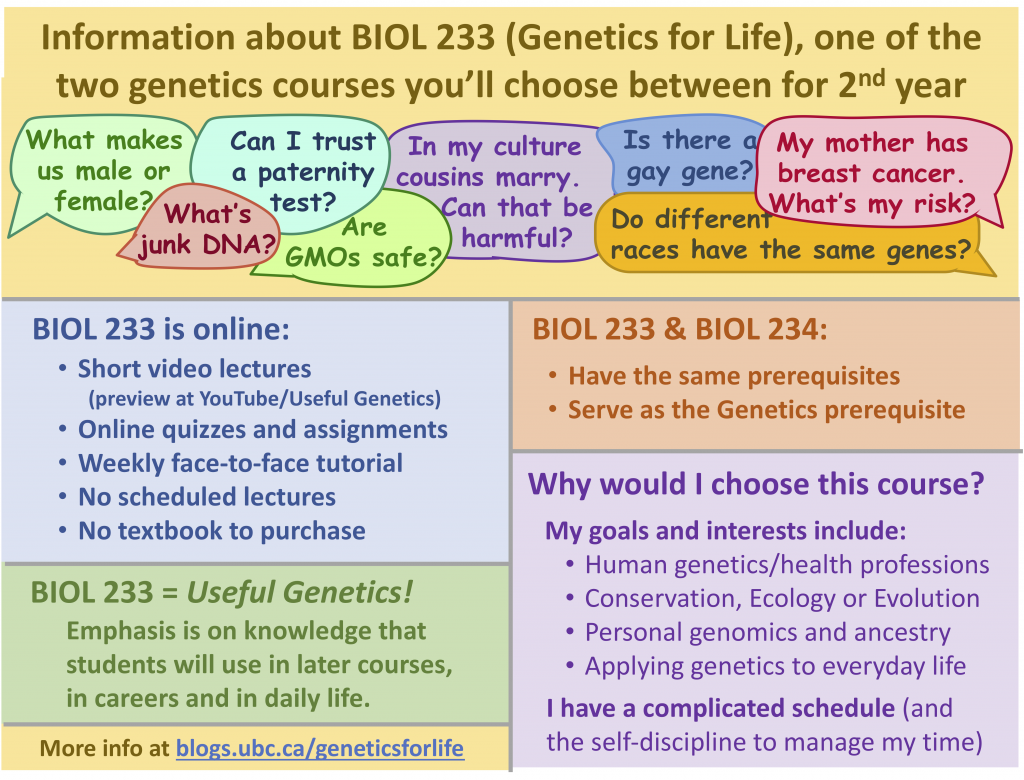Detailed information about Genetics for Life (BIOL 233)
Genetics for Life (BIOL 233) is one of the two introductory genetics courses available to UBC students. The information on this page is provided to help registering students choose between it and the alternative course, Fundamentals of Genetics (BIOL 234)
Who might choose Genetics for Life:
- Students planning careers in such health professions as medicine, dentistry and pharmacy: It emphasizes human genetics (no fruit flies), and covers the genetic basis of human differences, personal genomics, and how mutations cause disease, especially cancer.
- Students planning to take upper-level courses in ecology, evolution or conservation biology: Genetics for Life puts strong emphasis on natural genetic variation, and on how genetic processes act on natural populations.
- Students interested in the personal and societal relevance of genetics: Genetics for Life provides students with the genetics background to understand personal and societal issues such as ancestry, gene editing, forensic DNA analysis and the differences between people from different parts of the world.
Format: Genetics for Life has a ‘flipped’ format, with short online video lectures and weekly face-to-face tutorials. It satisfies the Biology Program genetics requirement, and the genetics prerequisite requirements for advanced courses. Its prerequisites are BIOL 112 and BIOL 121 (the same as for BIOL 234).
- The video lectures are continuously available online; students may access any lecture at any time. Lecture videos are also available on the Useful Genetics YouTube channel.
- Transcripts and slides for each lecture can be downloaded for easier offline studying.
- Many practice problems are also provided online.
- The weekly tutorials use a problem-based learning approach; students work in teams to analyze and explain genetic phenomena.
- To maximize flexibility for students, one of the tutorials has been scheduled for 5:30-7:30 pm on Thursday evenings. (The others are Tues. 1:00-3:00 pm, Tues. 3:00-5:00 pm and Thurs. 3:30-5:30 pm.)
- Assessment is by online problem-solving quizzes, short writing assignments, tutorial tasks and written (paper) midterm and final exams. All assessments are open-book.
In Fall 2019 Genetics for Life will be co-taught by Professors Rosemary Redfield and Judith Mank of the Department of Zoology. If you have any questions we haven’t answered above, you can post them as a comment below or directly email Dr. Redfield or Dr. Mank.
Week-by-week Syllabus:
- How different are we? Introduction to DNA, genes and chromosomes and the relationships between human populations.
- How DNA molecules change. The causes and immediate consequences of mutations.
- DNA differences and gene functions. Protein structure and function. How mutations that change gene activity or function affect the properties of organisms. Interactions between different alleles.
- Genetic interactions. Sex determination and genes on sex chromosomes. Interactions between different genes. How mutations cause cancer.
- Natural genetic variation. How natural genetic variation is studied, and how it differs from the variation usually presented in textbooks. Heritability and genome-wide association studies. Genetic variation for cancer risks.
- Personal genomics. Kinds of DNA typing and genome analysis, and what can be learned from them about health risks, personal attributes and ancestry.
- The mechanics of inheritance. How genes and chromosomes are transmitted through the generations (including the molecular mechanisms of mitosis and meiosis).
- Genetic analysis. Using genetic crosses as a research tool to investigate how genes work and what they do. Sex-linkage, pedigree analysis, and hypothesis testing.
- All about breeding and inbreeding. More about heritability and GWAS. Inbreeding in humans, crops and livestock, and evolution. Hybrids and genetically modified organisms.
- Chromosomal changes. Polyploidy and aneuploidy, chromosome rearrangements, and genome evolution.
- Selected advanced topics. The origin of life, mitochondrial genes and mutations, genetic mosaicism, fetal DNA in mothers, epigenetic inheritance, gene editing using CRISPR and other techniques.

